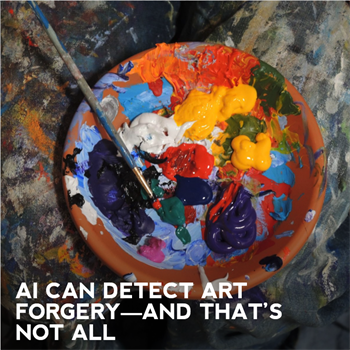AI Can Detect Art Forgery—and That's Not All
June 19, 2019 | In the PressFrom Mind Matters (https://mindmatters.ai/2019/06/ai-can-detect-art-forgery-and-thats-not-all/)

Crunching a great deal of data about some very small things, AI can provide a stream of information to help detect multi-million-dollar forgeries. For example, every artist’s brush strokes differ but only minutely:
In a new paper, researchers from Rutgers University and the Atelier for Restoration & Research of Paintings in the Netherlands document how their system broke down almost 300 line drawings by Picasso, Matisse, Modigliani, and other famous artists into 80,000 individual strokes. Then a deep recurrent neural network (RNN) learned what features in the strokes were important to identify the artist.
JACKIE SNOW, “THIS AI CAN SPOT ART FORGERIES BY LOOKING AT ONE BRUSHSTROKE” AT TECHNOLOGY REVIEW
The paper is open access.
Many older methods of detecting art forgery yield results. Most of them are high-tech (microscopy, X-ray, mass spectrometry, infrared reflectography). But the first step is rather low-tech: provenance:
Provenance investigators, then, unravel the history of an artwork using public and private records, archives, and other art historical research methods. At times, through looking at correspondence, catalogues, sales receipts, and even the artwork itself they discover it was very unlikely or even impossible for an artist to create a particular work. At other times, they might uncover a previously unknown legitimate record of the artwork’s existence which provides strong evidence that it is real.
UNIVERSITY OF GLASGOW, “USING SCIENCE TO DETECT ART FORGERIES” AT FUTURELEARN
If a disputed work passes the “Is it possible?” test, high-tech methods can increase the probability to beyond a reasonable doubt. But, of course, no one can ever say for certain. The problem is more along the lines of knowing when and why to suspect forgerybecause life is messy:
Leaving straight forgeries aside, any discussion about the “authenticity” of an artwork opens suddenly, like a trapdoor, into the murk of semantics. On the sliding scale of attribution that art historians use – painted by; hand of; studio of; circle of; style of; copy of – each step takes the artist farther from the painting. These variations, often subtle, are compounded by the unease about overpainting; Salvator Mundi had been worked over so many times and so heavily, critics argued, that it was less by Da Vinci than by his restorers. Deliberate fakes, misattributions and poor restorations all encroach into the realm of the authentic. In two decades at the Met in New York, Thomas Hoving, the museum’s director until 1977, must have examined at least 50,000 objects, he wrote in his book False Impressions. “I almost believe that there are as many bogus works as genuine ones.”
SAMANTH SUBRAMANIAN, “HOW TO SPOT A PERFECT FAKE: THE WORLD’S TOP ART FORGERY DETECTIVE” AT THE GUARDIAN
Is a perfect forgery possible?
As a thought experiment, it is possible to envision the immaculate forgery – the one that defeats scientist and connoisseur alike. Our villain is a talented copyist, well practised in the style and the themes of his chosen artist. He is also a resourceful procurer of materials, able to rustle up every kind of age-appropriate canvas and frame, pigment and binder. He fits his forgery neatly into a chain of provenance – giving it the title of a now-lost work, or providing false documents to claim that it had been part of a well known private collection.
In theory, if each of these steps is perfectly performed, there should be no way to expose the painting as fake. It will be a work of art in every way save one. But the world of today, the world in which the forgery is being created, is likely to fix itself in some form within the painting – as radioactive dust, perhaps, or as cat hair, or a stray polypropylene fibre. When that happens, only the scientist can hope to nab it.
SAMANTH SUBRAMANIAN, “HOW TO SPOT A PERFECT FAKE: THE WORLD’S TOP ART FORGERY DETECTIVE” AT THE GUARDIANOr perhaps the forger neglected to get hold of and use the newly developed AI to perfectly replicate the brushstrokes…
The most significant use of AI in art may be the much less sensational role of sorting out controversies over who painted what in situations where forgery is not in question. Art history is more complex than we think. As Subramanian notes, great artists might paint the same theme several times, students or other artists might fill in paintings, and lesser artists might copy the work, maybe changing it. Machine learning systems, trained on hundreds of images, can spot tiny similarities that identify a style and thus tell a story of composition:
The computer, says Honig, can pick up “so many more details, so much more easily”. Take windmills: hundreds of pictures featuring them fill her Brueghel database. The algorithm has picked up identical images of the structures in multiple paintings. It can even show when a replica has been flipped. And it has helped to pinpoint exact copies of lions, dogs and other figures. The workshops of many Renaissance artists were co-working spaces, so the computer technique helps Honig to piece together how different artists, in the family or not, might collaborate. “Rubens comes in and does some figures, and then Jan Breughel comes in and does the horses, the dog and the lion, because he’s ‘Mister Animal’,” Honig says. “And so they fit the things together.”
Many art historians surmised, on the basis of records and close observation, that this is what happened with numerous paintings by the younger Brueghels. The computer helps to prove it. Hong says: “It addresses a lot of questions about the process of production.”
DAVID ADAM, “FROM BRUEGHEL TO WARHOL: AI ENTERS THE ATTRIBUTION FRAY” AT NATUREBy the very nature of collaborative work, if simple fraud for financial gain is not in question, many much harder questions remain, questions where AI might provide some information that enables better judgment. But hardly the stuff of “AI Is Taking Over.”





